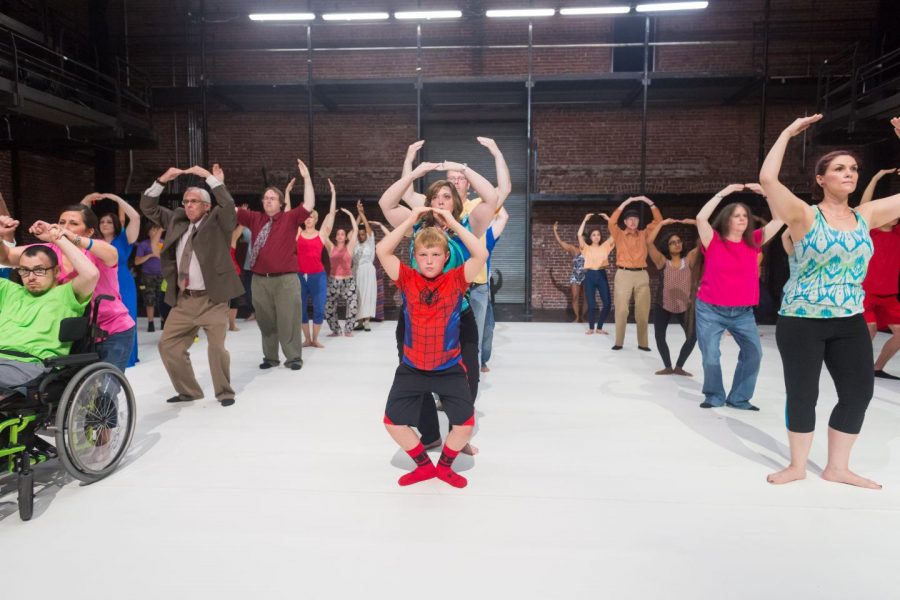City of Asylum offers ad-lib insight into lives of the disabled
June 9, 2015
Bright, fluorescent lights poured down on a cast of characters. They joined hands and bowed, their bodies casting shadows on the white stage where they stood. Some were standing, some accompanied by their caregivers and some in wheelchairs.
At the New Hazlett Theater in the North Side, “A (micro) history of world economics, danced,” showed last Friday and Saturday evening. Pascal Rambert, a French director, created and choreographed the show, and the local nonprofit City of Asylum helped to produce it. “A (micro) history” is part of an ongoing celebration of the 25th anniversary of the Americans with Disabilities Act, a piece of legislation which enforced anti-discrimination regulations to benefit disabled individuals. Some performers were wheelchair users who could not walk, and some were partially deaf.
The work, inspired by the 2008 global financial crisis, aims to show the effects of the economy on people’s lives. It has showcased in New York, Los Angeles, Paris and Cairo, among other cities. Each performance differs because the actors, who are not professional performers, customize the script and choreography during a week of workshops before rehearsals begin. The unconventional cast emphasizes inclusiveness and diversity by featuring performers with a range of disabilities, their caregivers and advocates for the disabled.
Henry Reese, one of the co-founders of City of Asylum, which provides sanctuary for writers exiled from their native countries for political reasons, said that the organization wanted to bring “A (micro) history” to Pittsburgh because the values and ideals of sharing art and diversity and giving a voice to people who are underrepresented aligned with those of City of Asylum.
“[The production] spoke to the core of what we are trying to do in giving voice to people who often go unheard and demonstrating the value of activities often deemed valueless, like art,” Reese said.
Reese added that City of Asylum and Rambert shared the goal of creating art that engaged communities that had little access to art, or art-making.
“In choosing to feature people with disabilities in the production, we also hoped to learn to be exceptionally hospitable to performers and audiences with disabilities,” Reese said.
As an interpretive dance piece with commentary on historical and modern economics, the production featured dancing, with narration by some actors. During one scene, an actor explained that the setting was early in human history. As the actors arranged themselves into two tribes, he explained how gift-giving evolved to form the basis of a trading economy. The featured actors added more historical background information and explained the settings and characters of each scene.
During another scene, all the actors came on stage with a personally significant item, such as photographs of deceased family members, doctoral dissertations, artist portfolios, baby blankets, toys and items representing hobbies and interests. After the actors held up their items and explained them, they left the items in front of the stage for the actors in the next scene to use as props. In this scene, banks evicted three performers from their homes, and the banks threw their sentimental possessions into the street.
Throughout the production, performers had small ad-lib asides, vocalizing their thoughts and sharing stories, which they prepared shortly before taking the microphone. Many performers spoke about times where their disabilities affected them and caused people to give them attention, whether it was a time when someone made an offensive comment, or a time when a stranger assisted them. One performer came to the microphone and signed, while a translator spoke, thanking the audience for coming, and reminded them to remember the struggles of the disabled.
After the performance, many of the attendees stayed to talk with the actors in the lobby. Patricia Sheahan, an attendee who enjoyed the performance, said the piece was inspiring and timely, given the amount of discrimination and violence taking place in the world.
“It inspires us to think about how we are the same and how we are all different,” Sheahan said. “I think after seeing [the production], we may have a different opinion about one another.”
Because each production of “A (micro) history” is different, each show has something new to offer. The performers in the Tokyo production of “A (micro) history” included people in wheelchairs, but Pittsburgh’s production included people with a broad range of disabilities. Some performers are sight- or hearing-impaired, some use wheelchairs and some have invisible brain trauma.
“This has been an enriching experience for Pascal as a director and a writer,” Reese said.
Many of the audience members lauded the message of diversity and acceptance, like Amanda Johnson, who had come to the show because she was curious about the premise and wanted to support the production.
“It’s very intricate. There’s a lot happening,” Johnson said. “I kind of want all theater to be this inclusive and accessible.”



